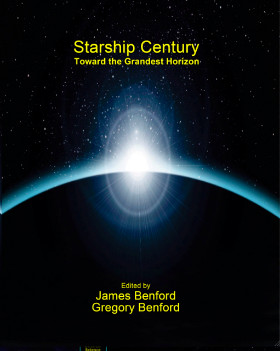Centauri Dreams
Imagining and Planning Interstellar Exploration
Laser Technologies for Starflight
How do we go about using photons to accelerate a spacecraft to a substantial percentage of the speed of light? Ten percent of c ought to do — it gets us to Alpha Centauri with a mission time of 43 years and would allow us to at least send flyby probes into that system, with the promise of larger decelerating probes as new technologies became available. After yesterday’s post on Young Bae’s photonic thrusters, I went back and read his 2012 paper “Prospective of Photon Propulsion for Interstellar Flight” (reference at the end). 10 percent of lightspeed is indeed the minimum he chooses. It works out to 30,000 kilometers per second.
Back in the 1950s, the German scientist Eugen Sänger talked about a ‘photon rocket’ as a way of reaching the stars, but his design called for annihilating electrons and positrons and using the gamma rays thus produced for thrust. The idea stumbled over the problem of controlling this kind of exhaust stream, for gamma rays penetrate anything we use to contain them. But the insight that photons themselves could be used to impart momentum to a sail was already in the air when Sänger was pursuing these notions, and it would not be long before beamed laser propulsion came to the fore as the subject of numerous papers on interstellar flight.
Beaming Energy to a Sail
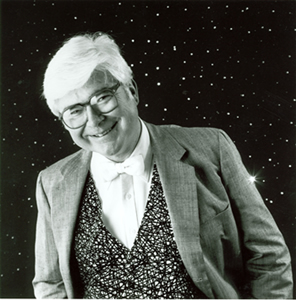
Robert Forward’s insights are repeated by Bae in his 2012 paper, which notes that separating the photon generators and the spacecraft pays numerous dividends. Propulsion systems that do not use rockets allow us to keep the heavy parts of the vehicle, especially the energy source, here in our own Solar System, while sending the payload out on its mission. As became clear yesterday, however, beamed laser propulsion also carries its share of problems, including the fact that we need to beam the laser photons over large distances. If you could forgive the need for Kardashev Type II engineering (able to use the entire energy output of its star), you could live with Forward’s huge Fresnel lenses, needed to keep the laser beam collimated, for laser beaming is based on reliably known physics. But we’re not exactly at Type II yet.
Image: Robert Forward, whose work on beamed laser propulsion produced designs that pushed engineering to extreme limits. Credit: UAH Library Robert L. Forward Collection.
Even so, assume a laser beaming capability using abundant solar power from a station near the Sun. A beam is sent out into the Solar System, to be focused by a huge lens presumably built by some kind of nanotech means out of local materials. Forward wanted to coax an interstellar mission out of these ingredients, and various permutations followed, culminating in 1984 in a concept for an interstellar round trip with a human crew. The destination would be Epsilon Eridani, 10.5 light years from Earth, to be reached using a lightsail with a diameter of 1000 kilometers, with a Fresnel transmission lens of the same diameter somewhere past the orbit of Saturn.
The numbers are staggering in every direction. With a total vehicle mass of 80,000 tons, including 3000 tons for the crew and its equipment, the lightsail would reach an acceleration of 0.5 lightspeed in less than two years. It would be accelerated by a 75,000 TW laser system. More on this mind-bending energy problem and its consequences in just a moment.
But first, how do we decelerate when our spacecraft reaches the target system? Without another laser installation already in place, Forward came up with a ‘staged’ sail concept, in which the lightsail is divided into nested circular segments. Approaching Epsilon Eridani (about 0.4 light years out), the rendezvous part of the sail with attached payload including crew detaches from the main body of the sail, allowing laser light to be reflected from what is now a 1000 km ‘ring sail’ back to the rendezvous sail. It’s this reflected light that decelerates the smaller sail and brings it into the Epsilon Eridani system. The sail will be divided again after the crew has finished its explorations. Now laser light beamed from Earth strikes the remaining 320 kilometer ring sail and accelerates the small inner sail and its crew module for the return trip. A final burst of laser light decelerates the spacecraft back into our Solar System.
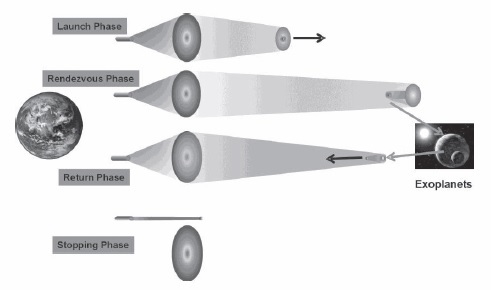
Image: A four stage roundtrip interstellar flight using Robert Forward’s ‘staged’ sail to decelerate. Credit: Young Bae.
All of this is purely conceptual, but it has led to numerous papers on the methods and materials of beamed laser propulsion, even as we’ve widened the scope of the research to include microwave beaming. Not long ago, Joe Ritter (University of Hawaii at Maui) explained to the 100 Year Starship Symposium his own work on ultra-large, highly adaptive space mirrors, which could have interesting sail implications. Perhaps some of these studies, along with advances in laser capabilities, will make beamed sails commonplace in the Solar System, a period of experimentation that could eventually lead to the first true interstellar missions.
Hybrid Missions with the Photonic Laser Thruster
Young Bae believes that beamed laser propulsion when combined with his own photonic laser thruster (PLT) can reduce the power requirements of Forward-style beaming by a factor of ten to one hundred, while using a short wavelength laser can reduce it yet again. Thus an infrastructure that would have become available no sooner than 2500 (Bae bases this on world power production and its yearly growth, recently analyzed by Tau Zero’s Marc Millis) becomes an actuality by the year 2100. His proposal is to perform initial flights of exploration but to follow them up with the construction of the ‘photonic railway’ we looked at yesterday. From the paper:
…the Photonic Railway… aims [at] enabling routine interstellar commutes via Spacetrains. The Photonic Railway, if successful, would radically depart from the conventional spaceship concepts, in which a single spacecraft carries both an engine and a large quantity of fuel. Rather, the Photonic Railway would have permanent reusable space structures that propel Spacetrains, which would consist of mainly crew habitats, and navigation and crew safety equipment. The technological foundation of the Photonic Railway lies on a strategic combination of BLP by Forward and PLT, which is named here PLT-BLP. It is predicted that the development of PLT-BLP can be further expedited by incorporating the anticipated development in x-ray lasers and advanced material science and technologies, and the interstellar PLT-BLP is projected to be within reach in a century.
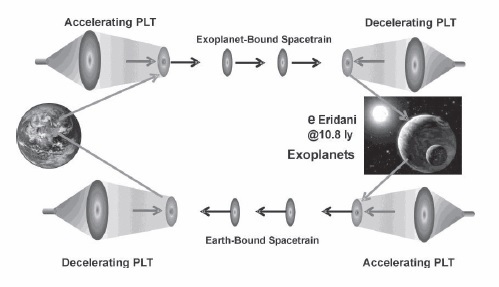
Image: Young Bae’s ‘photonic railway.’ It consists of four PLTs: two for acceleration and two for deceleration. The spacetrain will have small thrusters for attitude control and most of the onboard spacecraft resources will be dedicated to crew comfort and safety. Credit: Young Bae.
The photonic railway is, then, infrastructure, a permanent transportation system that would link nearby stars. Rather than a single laser beam from Earth, the beam is generated along the way. The structural parts for the lensing and laser systems must be delivered from Earth, but Bae envisions assembly and activation by self-directing robotic systems at the destination world. His paper illustrates a photonic railway using four photonic laser thrusters, two for acceleration and two for deceleration. The vehicle, or ‘spacetrain,’ would have thrusters for attitude control, but most of its resources would be dedicated to crew safety. The paper continues:
One important factor is that the Photonic Railway PLT needs to operate [a] much shorter distance than the distance between the earth and the exoplanet. Typically, depending on the Spacetrain acceleration condition (the optimal case would be 1 g acceleration for maximum crew comfort), the system operation distance would be at least a factor of 3.2 shorter than the flight distance. Because of this, the Photonic Railway optical system can be at least a factor of 10 smaller in size than the PLT-BLP optical system.
The paper goes on to sketch out this permanent transport structure, one based on the idea of photon propulsion that would act much as the transcontinental railway systems did at creating investment interest and economic opportunities. Building the photonic railway would involve a four part process beginning with the use of photonic thrusters in satellite maneuvering and leading to a lunar photonic railway, an interplanetary version, and ultimately the interstellar objective. Bae believes it is critical that each step provides return investment, and cites factors such as NEO mitigation, lunar mining and space solar power as early drivers toward this end.
Ultimately, Bae takes beamed laser concepts that have been extensively studied and combines them with photonic laser thruster technology, adding expected developments in x-ray laser and advanced material science to reduce the power and engineering requirements demanded by the missions Forward looked at. The goal is a photonic railway that is permanent and efficient. The citation is Bae, “Prospective of Photon Propulsion for Interstellar Flight,” Physics Procedia (2012), pp. 253-279. The classic Robert Forward paper is “Roundtrip Interstellar Travel Using Laser-Pushed Lightsails,” Journal of Spacecraft and Rockets 21 (1984), pp. 187-195.

Laser Travel by Photonic Thruster
A recent article in Popular Mechanics about Young K. Bae’s work on laser propulsion is generating some buzz, enough that I went back to look at the 2008 report Bae did for the NASA Institute for Advanced Concepts. Actually there are two reports, a Phase I and a later Phase II (with additional funding) on the topic of “A Contamination-Free Ultrahigh Precision Formation Flight Method Based on Intracavity Photon Thrusters and Tethers.” Bae was interested in spacecraft formation flight down to precisions of mere nanometers.

The idea relates to missions that would use multiple spacecraft to study astronomical phenomena. In fact, setting up a proper configuration would allow the study of biosignatures in the atmospheres of terrestrial exoplanets, using the technique of interferometry. Here the image produced has a resolution equal to that of a telescope as large as the maximum antenna separation, but the spacecraft involved have to maintain their alignment. Both ESA (with the Darwin mission) and JPL (with one configuration of Terrestrial Planet Finder) have studied interferometry in this context, and Bae’s work would assist such formation flying.
Image: Physicist Young K. Bae. Credit: Y. K. Bae Corporation.
Making it possible, in Bae’s view, was the use of laser methods in combination with tethers, but the work has grown beyond that original concept into what is being described as a ‘photonic laser thrust system,’ in which a laser is generated in a cavity between two mirrors. The resultant beam is fired from a space-based launch platform stabilized by conventional thrusters, and now we’re in territory made familiar by Robert Forward, who envisioned enormous laser installations firing beams to departing ‘lightcraft,’ sails pushed by laser light all the way to nearby stars.
The photonic laser thruster (PLT) is described on Bae’s website as:
…an innovative photon thruster that amplifies photon thrust by orders of magnitude by exploiting an active resonant optical cavity formed between two mirrors on paired spacecraft. PLT is predicted to be able to provide the thrust to power ratio (a measure of how efficient a thruster is in terms of converting power to thrust) approaching that of conventional thrusters, such as laser ablation thrusters and electrical thrusters. Yet, PLT has the highest specific impulse (a measure of how fast the fuel can propel spacecraft) orders of magnitude larger than that of other conventional thrusters.
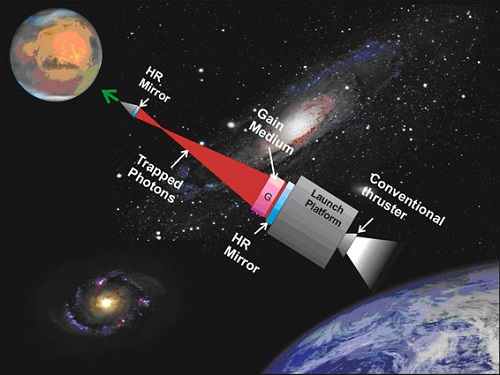
We’re very early in this game, although a small amount of research on beamed propulsion to sails has been performed in the laboratory by Jim and Gregory Benford. A space-based experiment using what was to have been the Planetary Society’s COSMOS sail never occurred after the sail’s launch failure in 2005, but even then the plan had been to use the Goldstone dish of the Deep Space Network to bounce a microwave beam off the sail to measure the effects. Laser experiments are sure to follow as we gain expertise at operating sails in space.
Forward’s laser installations would use abundant solar power from orbits near that of Mercury, firing out a laser beam that would have to be kept narrow — collimated — by a vast lens built in the outer Solar System. The same problem occurs with Bae’s lasers, but at least in the early days, he’s talking about near-Earth and lunar missions, and eventual flights to Mars. The diffusion problem occurs as we start contemplating significantly longer missions. And note this, from the article: “One compensation is the idea of doing smaller platforms to create a ‘photonic railway,’ each acting as a sort of refueling station in between to get the craft where it needs to be.” Here Charles Quarra’s idea of using multiple lenses for beam refocusing comes to mind.
Popular Mechanics doesn’t mention it, but Quarra’s ‘starway’ concept grows out of work first performed by Geoffrey Landis back in the 1990s and posits an eventual ‘light bridge’ connecting nearby solar systems (see A Light Bridge to Nearby Stars for more). Bae is evidently studying beam collimation in terms of ‘Bessel beams’ as well, beams that do not diffract like a conventional laser. What both these ideas get us away from is the need Forward saw of building a lens somewhere beyond the orbit of Saturn that would focus the laser light tightly on the departing spacecraft. Such lenses would demand building space artifacts the size of Texas.
Photonic laser thrusters have now received a Phase II grant from the resurrected NIAC, with the focus on the near-term development of the technology for spacecraft maneuvering and formation flying. For the longer view, see Dr. Bae’s “Prospective of Photon Propulsion for Interstellar Flight,” in Physics Procedia Vol. 38 (2012), pp. 253-279 (abstract), which describes a ‘photonic railway’ that would, in Bae’s words, “…bring about a quantum leap in the human economic and social interests in space from explorations to terraforming, mining, colonization, and permanent habitation in exoplanets.” That’s an energizing goal, but let’s get formation flying using photonic thrusters demonstrated first to see how all this scales up.

The Ethics of Unintended Consequences
Diplomat and author Michael Michaud returns to Centauri Dreams with a look at interstellar probes and how we might use them. Drawn from a presentation originally intended for the 100 Year Starship Symposium in Houston, the essay asks what effect our exploring another stellar system would have on its possible inhabitants. And beyond that, what effect would it have on us, as we weigh ethical issues and ponder the potential — and dangers — of highly intelligent artifacts going out into the galaxy? Michaud is the author of the indispensable Contact with Alien Civilizations: Our Hopes and Fears about Encountering Extraterrestrials (Springer, 2007). Among his numerous other works are many on space exploration. He was a U.S. Foreign Service Officer for 32 years, serving as Counselor for Science, Technology and Environment at the U.S. embassies in Paris and Tokyo, and Director of the State Department’s Office of Advanced Technology. He has also been chairman of working groups at the International Academy of Astronautics on SETI issues.
by Michael A. G. Michaud
Although the planets may belong to organic life, the real masters of the universe may be machines. We creatures of flesh and blood are transitional forms.
— Arthur C. Clarke
A Paradigm Reversed
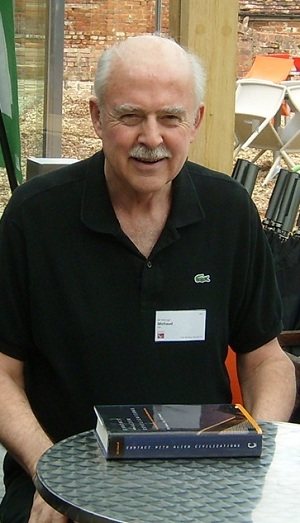
For the past forty years, nearly all published work about the impact of contact with an extraterrestrial civilization has foreseen that it will be one way, from the aliens to us. These scenarios have rested on an assumption that any alien civilization detectable by its technological activity must be more scientifically and technologically advanced than we are.
The 100 Year Starship Study is bringing this paradigm into question, because of an anticipated change in human capabilities. We are talking about sending our own machines to visit nearby star and planet systems. This is the beginning of a role reversal.
We could be the first technological civilization to begin expanding its presence into this region of the galaxy. The impact of contact, whether intended or not, might flow from us to others.
If there are alien forms of intelligence in any of the target systems, they may be less scientifically and technologically advanced than we are. If those other sapient beings live in pre-industrial societies, they may not be detectable before our probe arrives.
On Earth, practical ethics imply that we should try to anticipate the effects of our actions. Our plans for our probe’s arrival in an alien system should have an ethical dimension.
Sending Out a Mind
Our first interstellar probe may include the most autonomous artificial intelligence we have built up to that time. While much of its behavior will be pre-programmed, the probe’s actions may not be determined solely by the instructions it receives from its makers. That probe must be able to adapt to unforeseen circumstances, in some cases to make its own decisions. How independent should that intelligence be?
During its long journey, such a machine might evolve by connecting data in new ways. The artificial intelligence could be mutated by the effects of radiation generated when the probe collides with interstellar matter.
An altered machine might make choices different from those its senders intended. Like the HAL 9000 in 2001: A Space Odyssey, the probe might override its programming, making its own choices about which actions it will take.
It may take years for our new instructions to reach the probe. It would take more years to know if the probe has obeyed those instructions.
Robot Warriors
We are seeing a preview of this issue in the military use of robots. Articles in Scientific American have warned of a threat from semiautonomous machines over which humans retain nothing more than last-ditch veto power. Some systems are only a software upgrade away from fully self-sufficient operation.
According to articles in The Economist, humans will increasingly monitor military robots rather than fully control them. Some robot weapons already operate without human supervision to save precious seconds. Defense planners are considering whether a drone aircraft should be able to fire a weapon based on its own analysis.
As autonomous machines become smarter and more widespread, they are bound to end up making life or death decisions in unpredictable situations, thus assuming – or at least appearing to assume – moral agency.
The Singularity
We have heard much about a Singularity predicted for less than twenty years in our future. At that time, human intelligences would be uploaded into machines, eventually becoming independent of biology.
Our interstellar probes could be the most advanced forms of such an uploaded intelligence. Sending out such intelligent machines could be a first step toward a post-biological galaxy.
A Second Singularity may begin when we lose control of the probe. The good news is that we would be sending our creation very far away, where it would pose the least potential risk to Humankind.

Recognizing Evidence
We commonly assume that our probe will give priority attention to whatever planet in the target system is most like Earth. What will our probe look for? High on that list will be evidence of life.
With a limited payload, interstellar probe designers will have to make choices among instruments. Those choices will rest on assumptions about the nature of life that prevail at that time.
Will the probe recognize evidence of life forms very different from the ones we know on Earth? What if the probe reports ambiguous evidence? What if we are not sure whether the phenomenon we discover is life or non-life, because it is so different from the life we know?
Even if forms of life exist on that far off world, the probe’s sensors might not detect them. A report that there are no signs of biology could clear the way for an eventual human colonizing mission.
Will the probe also look for evidence of intelligence? Will it recognize such evidence in a society that does not emit electromagnetic signals and does not pollute its atmosphere with the by-products of industry?
Should our probe send signals to whatever planets it observes? Would local intelligences be able to receive such messages, or understand them?
It is conceivable, though not probable, that our astronomers will remotely detect signs of intelligent life in a nearby system before we launch a probe. Should we send a probe to that destination, or avoid it?
The Consequences of Contact: A Mirror Image
What would be the impact on intelligent beings who detected our probe? How would they react? This could be seen as a mirror image of the debate among humans about the consequences of contact for us.
What if the extraterrestrials had believed that they were the universe’s only intelligent beings, as most humans have believed about themselves? What if an alien technological civilization had used astronomical instruments to survey planets around other stars as we are doing now, and had found no evidence of the kind of biochemistry they know? They might have concluded that they were alone.
Even if they had imagined life and intelligence on faraway planets, they may not have thought of interstellar exploration. They may not have anticipated direct contact. Our probe’s arrival in their system could be a startling surprise.
Detecting evidence of an alien technology in their system would tell them that at least one civilization had achieved interstellar flight. They would know that contact could be direct.
To extraterrestrials, we would be the powerful and mysterious aliens, whose character and purposes are unknown. Suddenly, they might feel vulnerable.
Alien impressions of Humankind would be determined by their understanding of our probe. What would they see as our motivation in sending it? Would they think that the detected probe was only one of many, part of a grand scheme of relentless interstellar colonization?
Consider what now seems the most likely form of such an encounter: a fly-through of the alien system. The probe’s high velocity would make the event brief. Our machine might not be detected. If it were, the extraterrestrial equivalent of skeptical scientists might say that a one-time sighting is not proof.
Arthur Clarke described such a scenario in his novel Rendezvous with Rama, in which a giant alien spacecraft flies through our solar system without stopping or communicating. The implied message was deflating: Humankind was not only technologically inferior, but also irrelevant.
Imposing Ethics on a Machine
We humans have set a precedent for regulating our behavior toward possible alien life during our interplanetary explorations. Protocols are in place to avoid contaminating other solar system bodies, and to prevent back-contamination of the Earth.
Implicitly, we have accepted a principle of non-interference with alien biology. Such rules may be extended to an interstellar probe, suggesting that our machine should not enter the atmosphere or land on the surface of a planet suspected to have life.
What should be our probe’s rules of engagement if it encounters intelligent life? Will our machine be able to make ethical choices? Can we give our probe a conscience? Should our probe obey Star Trek‘s often violated Prime Directive, observing the other civilization while keeping our presence secret?
Before Star Trek, Stephen Dole and Isaac Asimov argued that contacts with alien intelligence should be made most circumspectly, not only as insurance against unknown factors but also to avoid any disruptive effects on the local population produced by encountering a vastly different cultural system. After prolonged study, a decision would have to be made whether to make overt contact or to depart without giving the inhabitants any evidence of our visit.
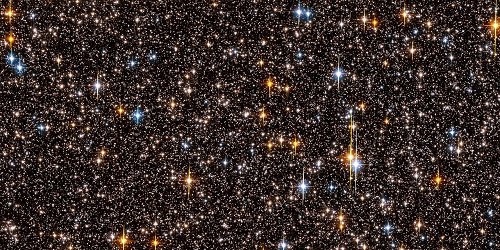
Image: The Hubble view in the direction of Sagittarius, looking toward the center of the Milky Way. The discovery of life around distant worlds raises huge questions of ethics and even self-preservation as we ponder what kinds of future probes we might send. What should a program of galactic expansion look like? Credit: NASA, ESA, K. Sahu (STScI) and the SWEEPS science team.
Future Behavior
Some of those involved in the extraterrestrial intelligence debate have assumed that a program of sending probes, once begun, would continue until all the Galaxy had been explored, perhaps by having probes reproduce themselves. This model has been used to dismiss the idea of extrasolar intelligences; if we don’t see their machines, they must not exist.
This model flies in the face of the only behavioral data base we humans have: our own history. No human expansion has continued unchecked. No technological program continues indefinitely.
Newman-and Sagan argued that self-reproducing probes will never be built because they constitute a potential threat to their builders as well as to other sentient species that encounter them. Wise civilizations would not create potential Berserkers.
What if we send several probes, and none finds a habitable planet? Would our interstellar probe program be abandoned like the Apollo manned missions to the Moon? Sending our first probes might be a technological catharsis, not to be repeated.
Conclusion
You who plan to build starships may be initiating a new phase in Galactic history. If we expand our presence beyond our Solar System through our probes, our role in the galaxy will begin to change.
We cannot foresee all the powers that our machines will have a century in our future, any more than people in 1913 could foresee what powers our machines have now.
We should think through the implications of succeeding ourselves with artificial Intelligence. What motivations should we instill in our intelligent machines? What limits on their behavior can we impose?
For those who would design artificially intelligent probes, I offer a warning. Be careful of what you loose upon the galaxy. Above all, do not give those machines the ability to reproduce themselves.
Someday, Humankind may praise or condemn what interstellar advocates and their successors actually do. Choose wisely.

White Dwarfs: Evidence for Watery Asteroids
The recent question raised here about conditions on a white dwarf planet provides a segue to the white dwarf GD 61 and the interesting results reported by astronomers at the Universities of Cambridge and Warwick. Relying on data from Hubble as well as Keck I and Keck II and NASA’s FUSE telescope, the researchers have analyzed what they believe to be evidence for an asteroid or minor planet that once contained large amounts of water around the star. The water-rich object would have been knocked out of its orbit and subsequently shredded by by the star’s gravitational force.

Image: Artist impression of a rocky and water-rich asteroid being torn apart by the strong gravity of the white dwarf star GD 61. Similar objects in the Solar System likely delivered the bulk of water on Earth and represent the building blocks of the terrestrial planets. Credit & Copyright: Mark A. Garlick, Space-Art.co.uk/University of Warwick/University of Cambridge.
GD 61 is some 150 light years from us, but spectrographic observations with the Keck instruments have made it possible to detect the basic ingredients of the disrupted material surrounding the white dwarf. Magnesium, silicon and iron show up in the star’s contaminated atmosphere, but so does significantly more oxygen than would flag the presence of rocky materials alone. Hubble’s Cosmic Origins Spectrograph is the key instrument in this finding. Boris Boris Gänsicke (University of Warwick) explains the significance of the oxygen levels:
“This oxygen excess can be carried by either water or carbon, and in this star there is virtually no carbon – indicating there must have been substantial water… This also rules out comets, which are rich in both water and carbon compounds, so we knew we were looking at a rocky asteroid with substantial water content – perhaps in the form of subsurface ice – like the asteroids we know in our Solar System such as Ceres.”
Substantial is the word, for the researchers believe the asteroid would have contained about 26 percent water mass, which is indeed similar to Ceres. The Earth, by comparison, has only 0.023 percent of its mass as surface water, an indication that our oceans were delivered by water-rich asteroids or comets long after the planet formed. Jay Farihi (Cambridge Institute of Astronomy) is quoted in this Keck Observatory news release:
“The finding of water in a large asteroid means the building blocks of habitable planets existed – and maybe still exist – in the GD 61 system, and likely also around a substantial number of similar parent stars. These water-rich building blocks, and the terrestrial planets they build, may in fact be common – a system cannot create things as big as asteroids and avoid building planets, and GD 61 had the ingredients to deliver lots of water to their surfaces. Our results demonstrate that there was definitely potential for habitable planets in this exoplanetary system.”
Before becoming a white dwarf, GD 61 was about three times more massive than the Sun, and the research team believes the detected water came from a minor planet at least 90 kilometers in diameter but probably larger, one that would have been orbiting the star before it became a white dwarf some 200 million years ago. The mass estimate is conservative because the observations can only detect what has been swallowed by the star in recent history.
The scientists also speculate that it would have taken the presence of one or more giant planets to perturb an asteroid orbit enough to send it inwards toward the star, a mechanism for continual pollution of the white dwarf’s atmosphere. We may be looking at something like what our own Solar System will look like in another five or six billion years, a scene future astronomers could likewise use to reconstruct the presence of terrestrial and gas giant planets. According to this University of Warwick news release, twelve destroyed exoplanets orbiting white dwarfs have been studied, but the GD 61 work marks the first time that evidence for water has been found.
The paper is Farihi et al., “Evidence for Water in the Rocky Debris of a Disrupted Extrasolar Minor Planet,” Science Vol. 342, No. 6155 (11 October 2013), pp. 218-220 (abstract).

Origins of Pluto’s Moons
Before getting into the distant regions near Pluto/Charon, let’s pause for a moment with a reflection on speed. New Horizons left Earth orbit traveling faster than any other vehicle launched into interplanetary space, although it has since slowed. Now the Juno mission is getting press for its velocity, perhaps impelled by this quote from Bill Knuth (University of Iowa), who is lead investigator for one of the probe’s nine scientific instruments. Of Juno’s recent close approach to Earth, Knuth says:
“Juno will be really smoking as it passes Earth at a speed of about 25 miles per second relative to the Sun. But it will need every bit of this speed to get to Jupiter for its July 4, 2016, capture into polar orbit about Jupiter. The first half of its journey has been simply to set up this gravity assist with Earth.”
The speed is impressive, about 40 kilometers per second, and far above Voyager 1’s 17.1 kilometers per second, as well as New Horizons’ expected 14 kilometers per second at the Pluto/Charon flyby in 2015 — after its sizzling departure, New Horizons has been slowing as it climbs out of the Sun’s gravity well. Juno has been pegged in some press reports as ‘the fastest man-made object ever,’ but its 40 kilometers per second doesn’t stand up to the two Helios probes, launched like Voyager back in the 1970s, which actually claim that title at 70 kilometers per second. Keep your eyes on the upcoming Solar Probe Plus for even faster velocities.
Amidst the Plutonian Moons
But back to Pluto/Charon, as I catch up with news from the AAS Division for Planetary Sciences meeting earlier this month in Denver. One of the curiosities about Pluto as we’ve discovered new moons there is their arrangement. Charon is the nearest and by far the largest moon, but what we see in the others is a steady succession that varies with Charon’s own orbital period. Thus Styx, Nix, Kereberos and Hydra present us with orbital periods that are 3, 4, 5 and 6 times longer than Charon’s own. That flies in the face of current models of formation of such moons, a situation that, according to Southwest Research Institute scientist Hal Levison, “suggests that we have been missing some important mechanism to transport material around in this system.”
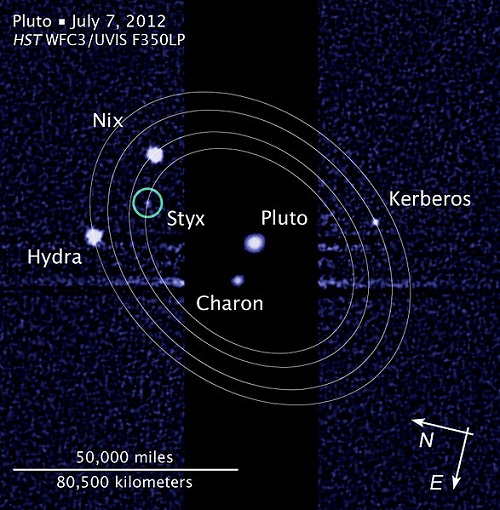
Image: A Hubble image of Pluto and its moons that has been modified by replacing “P4” and “P5” with the newer designations “Kerberos” and “Styx” respectively. Credit: NASA/Wikimedia Commons.
The SwRI study, described in this news release, modeled Charon itself by assuming a large impact in the early system, with additional moons built out of debris from this and other presumed collisions. Charon is fully one-tenth the mass of Pluto (by comparison, the Moon is 1/81 the mass of Earth), and its effect on early moon formation would be profound. Small moons that approached it would be flung outward while other small moons would collide, a series of early catastrophes that would lead to moon-building materials being pushed outward.
“The implications for this result are that the current small satellites are the last generation of many previous generations of satellites,” said Dr. Kevin Walsh, another investigator and a research scientist in SwRI’s Planetary Science Directorate at Boulder, Colo. “They were probably first formed around 4 billion years ago, and after an eventful million years of breaking and rebuilding, have survived in their current configuration ever since.”
All of which leads me to the New Horizons Message Initiative that was first announced at the 100 Year Starship Symposium in Houston not long ago. If you haven’t signed the NHMI petition yet, please visit the site and do so. The plan is to reconfigure a small portion of New Horizons’ computer memory, once its mission has been accomplished at Pluto/Charon and any Kuiper Belt objects beyond, so we can upload a message from humanity that will be crowd-sourced from all over the world. This is a private initiative and we need petition signatures to persuade NASA to consider this follow-up to the original Voyager ‘golden records.’ The NHMI is being developed through the capable work of Jon Lomberg and a team of volunteers. Lomberg’s work with Frank Drake in designing the cover for the Voyager records helped us gain perspective on our place in the cosmos as we reflected on what sights and sounds best represent our species.
Notes & Queries 10/15/13
Starship Century in London
A new Starship Century Symposium will be held at the Royal Astronomical Society, Piccadilly, UK on Monday October 21st. If I hadn’t exhausted my travel budget by September, I would definitely have this one on my agenda and follow it with a week or so in my favorite city. Here’s the information I have on the event from its organizers, James and Gregory Benford:
Starship Century addresses the challenges and opportunities for our long-term future in space, with possibilities envisioned by featured speaker Lord Martin Rees, Royal Astronomer, Ian Crawford, Birkbeck College, University of London, writer/scientist Stephen Baxter, James Benford, Microwave Sciences, and Gregory Benford, UC Irvine. Starship Century discusses the implications that these explorations might have upon our development as individuals and as a civilization.
Agenda
- 10 am Starship Century: Toward the Grandest Horizon James & Gregory Benford
- 10:30 Scientific Benefits of Starships Ian Crawford
- 11:30 Contact at Alpha Centauri Stephen Baxter
- 1 pm -Break for lunch-
- 2 pm To the Ends of the Universe Lord Martin Rees
- 3:30 Exploring Interstellar Space Panel with Lord Martin Rees, Ian Crawford, Stephen Baxter, Jim & Greg Benford, others TBA
- 5 pm Symposium ends.
Proceeds from the sale of the Starship Century book go toward interstellar studies. Admission to the event is free.
Project Icarus Workshop
Yet another reason to get to the UK is the latest from Project Icarus, the continuing effort by Icarus Interstellar to produce a fusion starship design growing out of the original Project Daedalus work in the 1970s. Here’s what I have on this one from the Icarus team:
Project Icarus is presenting the results of our preliminary fusion-rocket based interstellar spacecraft at the British Interplanetary Society in London on October 21 and 22nd, 2013.
We are asking for support in raising $2000 to support our volunteer researchers and students attending the workshop. All donations made to Icarus Interstellar through October will be channeled to support the “2013 Project Icarus Design Competition”. FOUR (4) breakway teams are presenting variations of spacecraft designs and mission configurations which will be presented during an internal workshop on the 21st, followed by a public symposium on the 22nd of October.
In appreciation of your support, donors will receive:
- $10 Your name listed in the acknowledgements of the final publication.
- $20 Icarus Interstellar Lapel Badge (and above)
- $50 Icarus Mug and t-Shirt (and above)
- $100 Advance copies of the INTERNAL Spacecraft Design studies (and above)
- $101 SPECIAL donations over $100 will receive an exclusive media pack containing HIGH RESOLUTION SPACECRAFT ENGINEERING DESIGNS rendered expertly by Adrian Mann (www.bisbos.com) (including all of the above!)
The exclusive content found in the INTERNAL Project Icarus Design Studies is the result of thousands of hours of research by our international volunteers. This is the FIRST TIME Icarus has shared full spacecraft designs. You can be among the exclusive few to explore our work first hand!
Icarus Interstellar the World’s Largest 501c(3) Deep Space and Interstellar Exploration Research Organization. All donations are tax exempt and deeply appreciated.
We are volunteers doing this work because it needs to be done.
Lets Build a Starship together!

White Dwarf Planets
My interest in planets around small stars is probably evident from the amount of space I spend on M-dwarfs and their planetary systems. Only recently have white dwarfs come into the picture for me, but as we’ve seen, Mukremin Kilic (University of Oklahoma) and colleagues have been discussing how to re-purpose the wounded Kepler observatory to look for transiting planets around such stars. About a year ago we also looked at Luca Fossati (The Open University, UK) and his work on the possibility of habitable white dwarf planets in exceedingly fortuitous orbits.
Now I have an email from science fiction writer Randy Blackwell, who has been working on a novel which raises interesting questions about habitable planets around white dwarf stars. Blackwell was looking for more details about possible conditions on the surface of such a world and I didn’t have the answers, so I thought it best to float his questions past the Centauri Dreams readership, many of whom have solved previous astronomical questions raised here.
Here’s Blackwell’s message about the scenario depicted in his novel:
The main characters find themselves on another planet. It is a water surface planet. The planet orbits a white dwarf. My complication is figuring out what the sky would look like by day and by night from the planet’s surface. Would there be an aura due to the great magnetism of the white dwarf? Would a dust trail be visible? If the desirable distance and size is 1 million miles at same size as Earth (both planet and dwarf) then what size would it look like in comparison to our Sun in the sky of the planet. Would it look closer or further? Would it be darker or more light with a 10 hour rotation?
I’m curious to see any answers to the questions Blackwell raises.
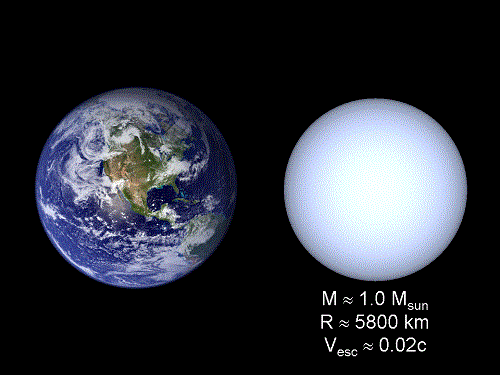
Image: A white dwarf as compared with the Earth. Credit: Ohio State University/Richard Pogge.
Deep Time in Aeon Magazine
A quick nod to Colin Dickey and his fine essay in Aeon Magazine on the Svalbard Global Seed Vault, which I actually encountered first in a post on the Long Now Foundation’s site. Looking at the lessons of geology and deep time, Dickey refuses to play the catastrophe card as a driver for long-haul projects like these. Calling the lessons of Svalbard “more complex than the simple, immediate apocalypse intimated by the hype surrounding the seed vault,” he goes on to say:
This recognition of the work of seed banks like the one in Svalbard is quotidian, bordering on the banal, and it can help to refocus an attitude towards the environment that sometimes verges on the self-important. A proper relationship to nature must involve a sense of stewardship, to be sure, and a willingness to work for a better tomorrow. But it might also do well to be stripped of a histrionic sense of perpetual catastrophe. Places such as Svalbard can help us to think on a much longer, deeper scale — one in which we are peripheral characters in a drama taking aeons to unfold.
In other words, a proper relationship between ourselves and the natural world is thoughtfully long-term whether or not global catastrophe ever forces us to rely on such repositories.


